(travelling with Catherina Wilson, June 2014)
The small rond point just at the market of Libenge has received a new painting: the logo of the UNHCR to announce a new phase in this small town’s existence. Libenge is a small town in Northern Congo, Province Équateur. It is just a small town, like so many others, so it seems at first sight. But underneath this ‘normality’ the hidden histories of promises and projects that have never come through make Libenge a very emotional and disturbing place. Will the invasion of the UNHCR, the United Nations agency for Refugees, be another white elephant, adding to the experience of lost hopes?
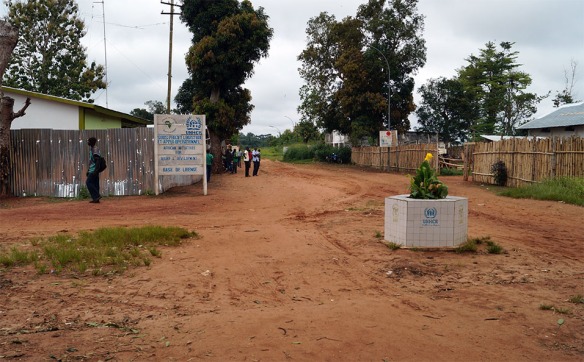 Why a blog about UNHCR in a counter voice narrative? Because what we have seen needs to be shared; but also because this type of organization functions as a Voice. The UNHCR as an organization makes in its actions a call to the World for the refugees. However, at the same time this Voice and the actions of the UNHCR generate and annihilate individual counter voices, by creating hope but humiliating these at the same time. Can we analyse this as a layered Counter Voice ‘effect’?
Why a blog about UNHCR in a counter voice narrative? Because what we have seen needs to be shared; but also because this type of organization functions as a Voice. The UNHCR as an organization makes in its actions a call to the World for the refugees. However, at the same time this Voice and the actions of the UNHCR generate and annihilate individual counter voices, by creating hope but humiliating these at the same time. Can we analyse this as a layered Counter Voice ‘effect’?
White Elephants
Libenge is situated in the homeland of Mobutu and the recently arrested ‘rebel’ leader Bemba. Bemba waits for his trial at the ICC in the Hague. Both Bemba and Mobutu have not lost their hero status for many people here. Some of the youth do not reject Mobutu’s 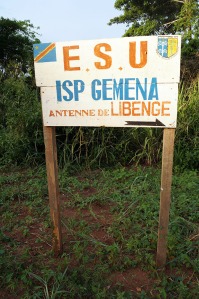 authoritarian regime, but instead compare it with the present-day situation, concluding that it was better then: anything is better than the rule of Kabila. Many of these young men and women do not have jobs. They try to make a living by being a taxi-bike (that is not their own) man, and do some farming, although they have no real clue to how to create a successful harvest. We visit some of the white elephants; an empty sugar factory, a huge construction that had to become the Panafrican University, and the airport where – until the arrival of the UNHCR – planes were only sporadically appearing.
authoritarian regime, but instead compare it with the present-day situation, concluding that it was better then: anything is better than the rule of Kabila. Many of these young men and women do not have jobs. They try to make a living by being a taxi-bike (that is not their own) man, and do some farming, although they have no real clue to how to create a successful harvest. We visit some of the white elephants; an empty sugar factory, a huge construction that had to become the Panafrican University, and the airport where – until the arrival of the UNHCR – planes were only sporadically appearing.
UNHCR’s arrival in the region dates from the time before the first refugees from CAR arrived in the camp. If the information of the sisters (Filles de Saint Joseph) is correct the UNHCR knew long before the conflict in CAR started about the need for refugee camps. They were preparing in 2012. The sisters therefore believe that this is all a set-up. We could not verify this early preparation. Was the influx of refugees foreseen? And what has been the role of international politics and interests? Answers will never be certain. But the presence of the UNHCR and many other Humanitarian NGOs in Libenge (and the region) is a fact. They create jobs, new public spaces, make prices of food and shelter rise, and introduce cars, improve roads, in short create another reality. And everybody knows UNHCR will not stay forever.
UNHCR Branding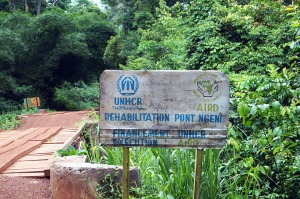
Travelling the road between Gemena and Libenge and between Libenge and Zongo (about 260 km) by motorbike, we meet fourwheeldrive cars from the UNHCR only, we see piles of wood, we meet the UNHCR sign boards. The fourwheeldrive cars can travel these bad roads, except for the bridges that were reconstructed recently by the UNHCR, as a ‘gift’. The big trucks that pass with a lot of trouble (often 14 days on the road) profit from these bridges. But there are no other cars. Only motorbikes help people from one town to the other. The piles of wooden planks along the road are now mainly bought by the UNHCR to create the camps. Building 25,000 huts and all the rest demands a huge amount of wood. Houses in the villages wear signs of the UNHCR, the UNHCR brand on the cloth that covers some of the hangars, but also the announcements of their good work: rehabilitation of a school, the reconstruction of a bridge, and the many t-shirts. And of course the big refugee camps along the road; one near Libenge (Boyabu) and the other nearZongo (Molè). The colours of the UNHCR, blue-white, are the marks of new buildings, new projects and aid money.
Refugee identity 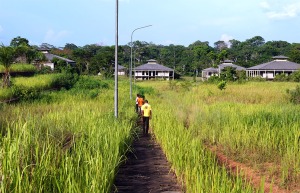
The presence of the UNHCR is part of the war economy/situation that we observe in this region; a war that this time comes from the Central African Republic. It is not the first confrontation with war in this region, coming from different sides, and stories of displacement are normal. This last conflict is considered the expected next. In the small towns offices of the UNHCR and the national refugee organization CNR (Congolese Council for Refugees) are the busy headquarters of the organizations. Decisions are taken here about the set up and regulations in the camps, and where the new refugees and displaced will go. Can Chadians join the camps or should they be sent to Kinshasa? These fleeing people who have left their homes and beloved ones behind obtain another identity here. Entering the registration procedure means that one becomes subject to UNHCR policy, applying juridical formats to these people’s identity; from which there is only a very difficult return. The refugee who was a free person becomes a ‘prisoner’ of humanitarian aid. The aid is attractive and hard to refuse, as there is no alternative. For many newly arriving refugees receiving 15 dollars a month per head is enough to survive. Though there will always be hunger and need for care. The decision to give money instead of food was based on a protest in one of the camps. The refugees did not like the distributed food. The other (probably outweighing?) reason was that the UNHCR could not organize the provision of the huge amounts of food, simply because of financial and infrastructural problems.
UNHCR machinery 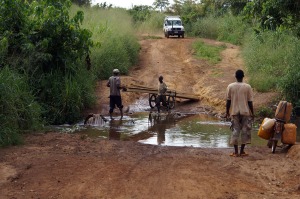
The UNHCR, their sub-contractors (like the CNR) and humanitarian NGOs thus install yet another dynamic in the region that will certainly direct people’s lives, for refugees and autochthones, and for the employees. It is remarkable that many of the higher cadre employees are from other regions in Congo. We meet quite a number of people who are from the East. Their explanations reveal that they have become part of the humanitarian circulation that started in the East of Congo, where the UN has been present for many years. It appears that the East was a ‘school’ for humanitarian aid practitioners. The equatorial province offers a new job market for these humanitarians. Perhaps such machinery of humanitarian aid is unavoidable. The world has no other model to care for people in extremely difficult/disaster situations. However the dynamics we observe are also counter-productive and double sided. Both the employees and the refugees are ‘victims’ of the organization. Although the employees are of course happy with their jobs, they do realize that life is not that easy as their families are elsewhere and they are confronted with misery on a daily basis; on the other hand the 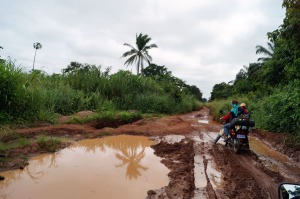 refugees become a kind of prisoners, with a subject identity. They will also be grateful for the help they receive. But is there not another way? Many lives are ‘crushed’ and will not be the same after calm has returned. The materials used by the UNHCR will not stay for long after the operation has stopped, the wood and batches will just perish; but the organizational and social structures they created and the mentalities put in the minds of many young and old people will stay, and it is not certain whether this will bring a durable future of peace. This time the white elephant is leaving its marks in the mentalities, and although material structures might not be left behind, it is as well enduring especially for the creation of sentiments that make the population anxious for their historical leaders; a returning sentiment that overrules these leaders’ terrible and violent deeds.
refugees become a kind of prisoners, with a subject identity. They will also be grateful for the help they receive. But is there not another way? Many lives are ‘crushed’ and will not be the same after calm has returned. The materials used by the UNHCR will not stay for long after the operation has stopped, the wood and batches will just perish; but the organizational and social structures they created and the mentalities put in the minds of many young and old people will stay, and it is not certain whether this will bring a durable future of peace. This time the white elephant is leaving its marks in the mentalities, and although material structures might not be left behind, it is as well enduring especially for the creation of sentiments that make the population anxious for their historical leaders; a returning sentiment that overrules these leaders’ terrible and violent deeds.
The UNHCR has a message to the world and is a Voice for a better world; but its existence is also based on this Voice. The model of the UNHCR has been developed on the basis of humanitarian models that unavoidably change people’s identities and create a reservoir of ‘refugees’, with another mentality, and ideas about the world. It creates people who will not be the counter voices of the future, but instead dependent and traumatized forever.
